
Folklore Museum “Nerantzis-Aivazis”
Audio Tour
1. Entrance
Welcome to the Nerantzis Aivazis Mansion, a timeless treasure nestled in the heart of Kastoria. As you stand before these grand oaken doors, imagine the countless stories they’ve witnessed since the 17th century. The mansion, now home to the Museum of Folklore, invites you to step back in time and explore a world where history and tradition intertwine.
Gently place your hand on the cool, aged wood of the door. Feel the texture of the intricate carvings, the weight of centuries resting beneath your fingertips. Above you, the soft gleam of a bronze bell hints at the warm welcomes that once echoed here.
To begin your journey, simply scan the barcode provided. This will be your guide, unlocking the secrets of each room, each artifact, and each whispered tale preserved within these walls.
Are you ready to embark on this adventure through time? Step inside and let the stories unfold.


2. Introduction and Background
As you cross the threshold into the mansion, the ambiance shifts. The air carries a subtle scent of aged wood and distant echoes of laughter and conversation. Sunlight filters through the windows, casting gentle patterns on the stone floor.
“You’re now standing in a place where history lives and breathes. The Nerantzis Aivazis Mansion isn’t just a building; it’s a living narrative of Kastoria’s resilient spirit during the Turkish occupation in the 17th century.
Imagine a time when the streets outside were filled with the hustle of merchants and the whispers of families adapting to new realities. The people of Kastoria, faced with challenges, transformed adversity into an opportunity to create something enduring.
This mansion is a testament to that ingenuity. Built like a fortress, it embodies the blend of necessity and artistry. Thick stone walls provided security, while elegant decorations reflected a love for beauty and culture.
At the heart of this story are two families: the Aivazis and the Chondroyannis. The Aivazis family, prominent fur merchants, brought wealth and international connections to Kastoria. Picture Demetrios Aivazis, a man of vision, walking these very halls, discussing trade routes and innovations in the fur industry.
Then there’s Tasia Chondroyannis, a matriarch known for her strength and grace. Her presence is felt throughout the mansion, from the carefully tended garden to the warmth that permeates each room. When her daughter, Theodora, married Demetrios, two legacies intertwined, and this house became a symbol of unity and prosperity.
As you explore each room, you’ll uncover layers of their lives—their joys, challenges, and the traditions they cherished. You’ll see how they adapted their home to meet the needs of their time while holding onto the cultural threads that defined them.
Ahead lies the Entrance Hall, where daily life in the mansion began. Each step you take brings you closer to the heart of their story.
3. Entrance Hall
Stepping into the Entrance Hall, you immediately sense the pulse of the mansion. The room is spacious, with high ceilings supported by sturdy wooden beams. The floor beneath you is paved with stone slabs, worn smooth by generations of footsteps.
“Close your eyes for a moment and imagine the lively bustle that once filled this space. Children darting through, their laughter echoing as they played hide-and-seek. Servants carrying baskets of fresh produce from the garden, the aroma of ripe fruits mingling with the scent of fresh bread.
To your right, there’s a heavy door leading to the Food Cellar. On your left, another door opens to the Wine Cellar. These were the arteries of the household, ensuring that the family and their guests were always well-provided for.
Above the main entrance hangs the bronze bell you noticed earlier. Envision it chiming softly as friends and relatives arrived, their visits bringing news and stories from afar.
The thick oaken door you passed through wasn’t just an entrance; it was a guardian. During uncertain times, it stood as a barrier against the outside world, its solid frame and intricate lock offering both security and a warm welcome to those invited inside.
This hall was more than a passageway; it was the heartbeat of the home. It connected the practical aspects of daily life with the warmth of family gatherings. From here, the sounds of conversations would drift up the stairs, mingling with the melodies of music during celebrations.
As you stand here, take a moment to absorb the energy of this space. Feel the coolness of the stone under your feet, the sturdiness of the walls around you. Imagine the sense of comfort and safety the family felt within these walls.
“You’re now standing in a place where history lives and breathes. The Nerantzis Aivazis Mansion isn’t just a building; it’s a living narrative of Kastoria’s resilient spirit during the Turkish occupation in the 17th century.
Imagine a time when the streets outside were filled with the hustle of merchants and the whispers of families adapting to new realities. The people of Kastoria, faced with challenges, transformed adversity into an opportunity to create something enduring.
This mansion is a testament to that ingenuity. Built like a fortress, it embodies the blend of necessity and artistry. Thick stone walls provided security, while elegant decorations reflected a love for beauty and culture.
At the heart of this story are two families: the Aivazis and the Chondroyannis. The Aivazis family, prominent fur merchants, brought wealth and international connections to Kastoria. Picture Demetrios Aivazis, a man of vision, walking these very halls, discussing trade routes and innovations in the fur industry.
Then there’s Tasia Chondroyannis, a matriarch known for her strength and grace. Her presence is felt throughout the mansion, from the carefully tended garden to the warmth that permeates each room. When her daughter, Theodora, married Demetrios, two legacies intertwined, and this house became a symbol of unity and prosperity.
As you explore each room, you’ll uncover layers of their lives—their joys, challenges, and the traditions they cherished. You’ll see how they adapted their home to meet the needs of their time while holding onto the cultural threads that defined them.
Ahead lies the Entrance Hall, where daily life in the mansion began. Each step you take brings you closer to the heart of their story.

4. Food Cellar
Descending a few steps, you enter the Food Cellar, or ‘Kelari’ as it was lovingly called. The air here is cooler, tinged with earthy aromas of stored grains and herbs. Soft light filters in through a small window, casting gentle shadows across the array of containers lining the walls.
“Picture the shelves filled with wooden tubs and earthenware urns, each one carefully labeled and sealed. Here, the family stored the staples of their diet—olive oil gleaming golden in the light, sacks of wheat and barley ready to be milled into flour, and jars of honey harvested from their own hives.
In one corner stands a wooden churn, worn smooth by years of use. Imagine Tasia or Theodora churning butter, the rhythmic motion a soothing routine amidst the day’s tasks. Nearby, strings of dried herbs hang from the ceiling—mint, chamomile, oregano—filling the room with their fragrant scent.
This cellar was a treasure trove of nourishment and a symbol of self-sufficiency. The family took pride in their ability to provide for themselves, preserving the bounty of each season to last through the year.
Think about the effort and care that went into maintaining this space. It wasn’t just about storing food; it was about ensuring the well-being of everyone in the household. During harsh winters or times of scarcity, this cellar would have been a source of comfort and security.
As you move through the room, you might notice a small nook where jars of preserves are kept—quince jelly, grape molasses, and pickled vegetables, each one a testament to the family’s culinary traditions.



5. Wine Cellar
Continuing your journey, you enter the Wine Cellar, a dimly lit sanctuary where time seems to slow down. The walls are lined with barrels of varying sizes, their wooden surfaces etched with the marks of cooperage and the family’s insignia.
“Imagine the rich, warm scent of fermenting grapes enveloping you. This was a place of both work and anticipation. Each barrel holds not just wine but the essence of gatherings yet to come—weddings, name days, and festive dinners where the wine would flow freely.
In the center of the room stands a small wine press, its mechanisms simple yet effective. Visualize family members crushing grapes harvested from their own vines, the deep purple juice flowing into vats for fermentation. Laughter and stories would accompany this labor, turning work into celebration.
The wine produced here wasn’t merely a beverage. It was a symbol of hospitality, an offering to guests, and a centerpiece of communal life. The sunned wine, a specialty of the household, was aged to perfection, its flavors deepened by time and care.
Think about the moments when Demetrios would select a bottle from these very racks, perhaps one laid down years before in honor of a child’s birth, now ready to be opened for a special occasion.
This cellar is a repository of patience and craftsmanship. Each bottle tells a story, each cask holds the promise of joy.

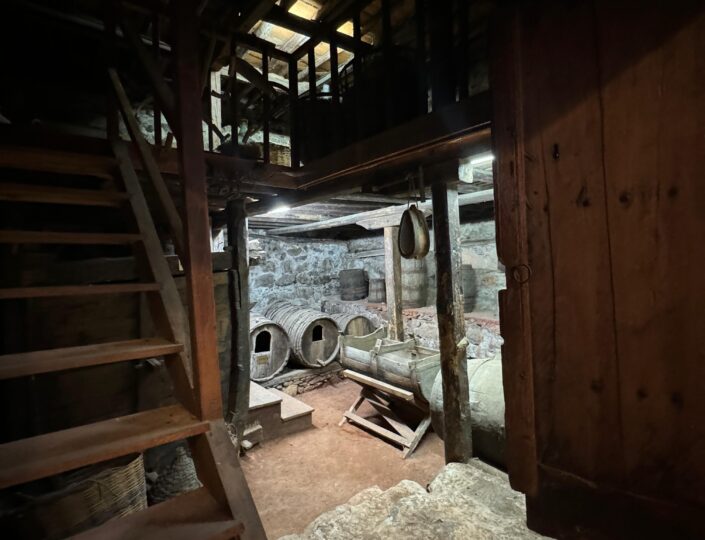

6. Place for Kneading Bread (Zymotari)
Ascending back to the main level, you enter the Zymotari, a room filled with soft light and the faint, comforting aroma of flour and yeast. The atmosphere here is one of homely warmth and nurturing.
“Imagine Theodora and her daughters gathered around the large wooden kneading trough, their hands dusted with flour as they work the dough. The rhythmic kneading is almost hypnotic, a dance of hands that has been performed countless times before.
On the wall hangs an array of rolling pins and wooden stamps, each one bearing intricate designs used to imprint special loaves for religious ceremonies or festive occasions. The stamps are carved with care, depicting symbols of faith and tradition.
The process of bread-making was more than a chore; it was a cherished ritual. The act of transforming simple ingredients into nourishing loaves connected the family to their ancestors and to the land that provided for them.
Picture the anticipation as the dough rises, covered with a linen cloth embroidered by a grandmother’s hand. The warmth of the room aids the fermentation, the yeast breathing life into the dough.
Once ready, the loaves would be taken to the outdoor oven or baked here in the hearth, filling the air with an irresistible aroma that drew children and adults alike.
Bread was the cornerstone of every meal, a symbol of hospitality and sustenance. Sharing bread meant sharing life.

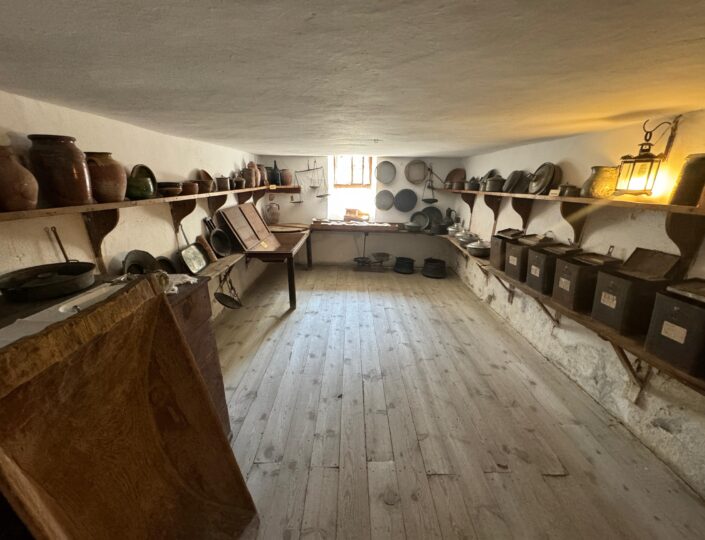






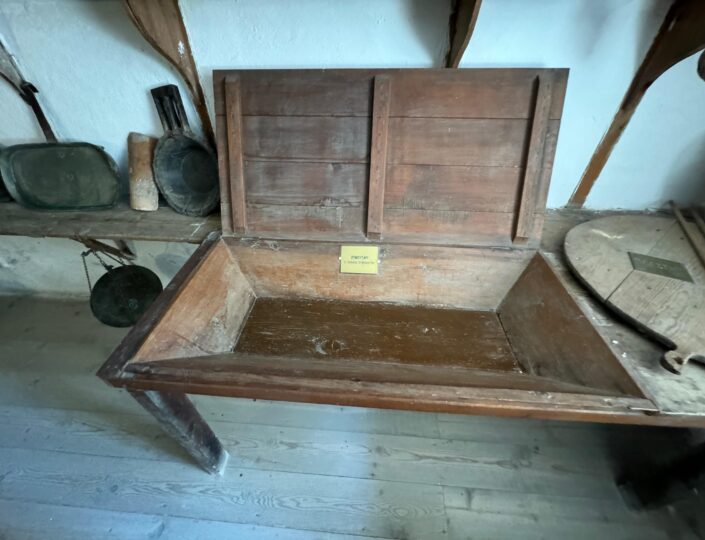
7. Basement for Fuel Storage
Descending a short staircase, you find yourself in the Basement for Fuel Storage. The room is cool and dry, with neatly stacked piles of firewood and bundles of kindling arranged with meticulous care.
“Envision the effort required to prepare for the long Kastorian winters. Family members, perhaps the sons or hired hands, would spend days chopping wood, ensuring that the household would remain warm and well-supplied.
The grapevines stored here served a dual purpose—pruned from the vineyard after harvest, they provided excellent kindling and reminded the family of the cyclical nature of their work.
Imagine the satisfaction of knowing that, no matter how fierce the storms outside, the fires within the bouchari fireplaces would keep the chill at bay. The crackling of logs, the glow of embers—these were the comforts that turned a house into a home during the cold months.
This storage wasn’t just about practicality; it was a manifestation of foresight and diligence. The family’s well-being depended on these preparations.”

8. Stable
Stepping into the Stable, the scent of hay and the imagined soft sounds of animals greet you. Sunlight streams through small windows, illuminating the stalls where the family’s livestock once resided.
“Picture a gentle cow turning her head to observe you, her eyes calm and wise. Perhaps a donkey brays softly from another stall, eager for attention or a treat.
The stable housed animals that were integral to the family’s livelihood:
Cows provided milk, butter, and cheese.
Sheep offered wool for spinning and weaving.
Donkeys and horses were essential for transportation and work in the fields.
Imagine young children helping with the chores, learning responsibility as they fed the animals and mucked the stalls. The bond between the family and their livestock was one of mutual dependence and care.
The stable was more than a functional space; it was a place where the rhythms of nature and the cycles of life were intimately observed. Births of calves or lambs would be moments of joy, reminders of renewal and abundance.
9. The Exterior Yard
Emerging into the Exterior Yard, you’re greeted by the open sky and the vibrant colors of nature. The stone pathway beneath your feet is warm from the sun, leading you through a space that is both inviting and serene.
“Envision the grapevines arching overhead, their leaves creating a dappled canopy that filters the sunlight. Clusters of grapes hang temptingly, promising sweet rewards later in the season.
Along the edges, flowering plants burst with color—roses, marigolds, and fragrant jasmine weave together, attracting butterflies and hummingbirds. The low stone walls encircle the yard, giving a sense of intimacy and protection.
This yard was the family’s outdoor living room, a place where they could relax after the day’s work. Imagine Tasia sitting on a bench, embroidering a delicate pattern as she listens to the laughter of her grandchildren playing nearby.
In the evenings, the family might gather here to watch the sunset, the sky ablaze with hues of orange and pink reflected in the lake beyond. Stories would be told, songs sung, and the worries of the day set aside.
The yard was also practical. Herbs like basil and thyme grew in pots near the kitchen, ready to be plucked and added to meals. A well in the corner provided fresh water, its cool depths a source of refreshment on hot days.
Feel the harmony between human habitation and nature. The yard is a testament to the family’s appreciation of beauty and their understanding of the land’s bounty.”
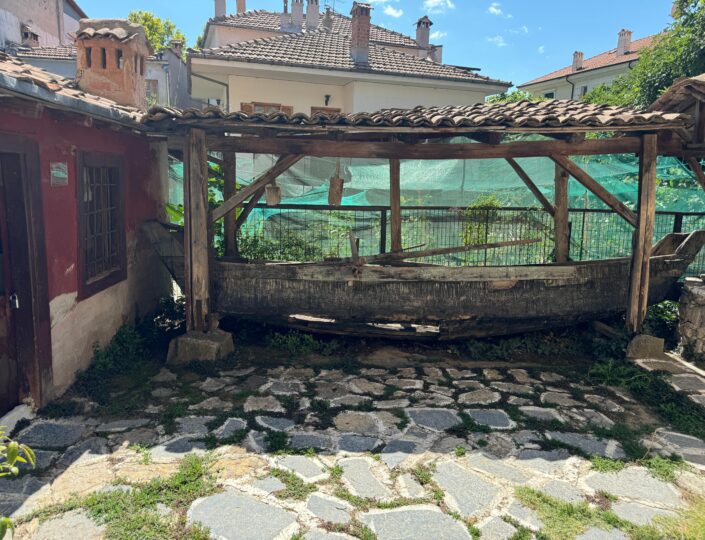
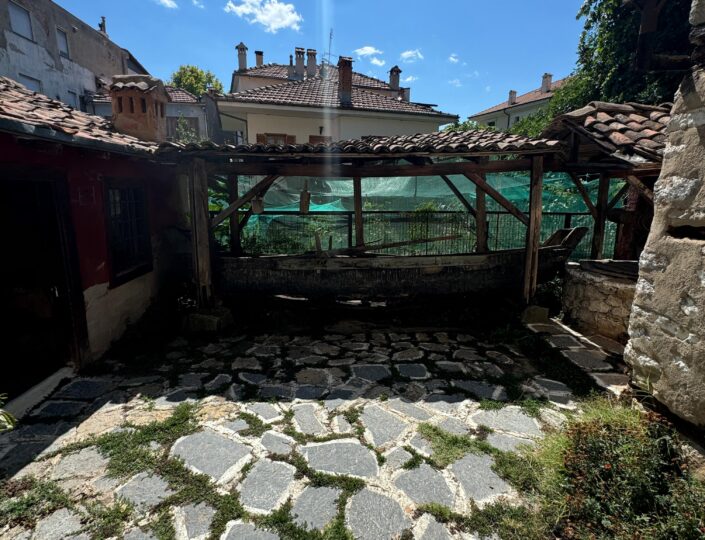
10. The Outdoor Kitchen
Adjacent to the yard stands the Outdoor Kitchen, an open-air pavilion that hums with the memory of culinary delights. The roof provides shade, supported by sturdy wooden pillars adorned with climbing vines.
“Imagine the bustle of activity here during harvest time. Large clay ovens glow with heat, the aroma of baking bread and pies wafting through the air. Pots of bubbling sauces and stews simmer over open flames, tended carefully by the women of the household.
In one corner, a copper still gleams in the sunlight, used for distilling raki, a traditional grape-based spirit. Picture Demetrios overseeing the process, ensuring the perfect balance of flavors for this cherished drink.
The wine vat nearby is a hub of excitement during the grape harvest. Family members, young and old, take turns crushing grapes underfoot, laughter ringing out as purple juice splashes around them.
This kitchen was a place of communal effort and joy. Cooking was not just a necessity but an art and a social event. Recipes were shared and passed down, each dish carrying with it the history and love of generations.
Visualize the long wooden table laden with fresh vegetables from the garden, baskets of fruit, and bouquets of herbs. The colors and scents create a feast for the senses even before the food reaches the table.
As the sun begins to set, the family gathers to enjoy the fruits of their labor, dining under the stars with the sounds of nature as their backdrop.


11. The Avgati (Lakeside Area)
Although we cannot physically visit the Avgati today, close your eyes and let your imagination transport you to the edge of Lake Orestiada as it once was.
“Envision a stone pier extending gently into the clear, shimmering waters. The surface of the lake mirrors the sky, reflecting clouds and the golden hues of sunrise or sunset.
Tall poplar trees line the bank, their leaves whispering secrets as the breeze rustles through them. At the water’s edge, wildflowers and reeds sway softly, creating a natural tapestry of colors.
The lake was a hub of activity and leisure. Picture Demetrios and his sons casting nets in the early morning, the anticipation of a fresh catch bringing excitement. Carp and golden minnows glint beneath the surface, their movements sending ripples across the water.
Children splash and play along the shore, their joyful cries echoing across the lake. In the evenings, the family might take a boat out, gliding across the tranquil waters as they share stories and songs under the starlit sky.
One beloved tale tells of the ‘Golden Minnows’, where the children would create nests of lakeweed to attract the shimmering fish, capturing them with simple nets—a game that blended play with the practical rewards of fishing.
The Avgati was more than a picturesque setting; it was an extension of the family’s home, offering sustenance, recreation, and a deep connection to nature’s rhythms.
12. The Platform
Continuing upward, you pause at the Platform, a landing that offers a moment of reflection between floors.
“This space serves multiple purposes. It’s a crossroads within the mansion, connecting various rooms and levels. Here, a screened food box hangs, a practical solution for keeping perishables cool and safe from pests.
On the walls, you might notice everyday items—a woven basket, an umbrella with a carved handle, a shawl draped over a peg. These small touches add to the lived-in feel of the mansion, reminding you that this was a home filled with activity.
From the platform, you can look down to the entrance hall, perhaps catching echoes of imagined voices or the distant chime of the bronze bell.
Appreciate the craftsmanship of the staircase, the smooth banister polished by countless hands, the subtle creak of the wooden steps—a soundtrack to the comings and goings of daily life.
13. Reception Hall (Doxatos)
Stepping into the Reception Hall, you’re immediately struck by its magnificence. The ceiling soars above you, adorned with intricate woodwork and painted motifs that captivate the eye.
“Imagine this room filled with the vibrant energy of a celebration. The walls echo with music and laughter, the air alive with the scents of flowers and fine foods.
The hall served as the heart of social life, hosting events like lavish weddings, festivals, and dances. Picture long tables set with gleaming silverware and crystal glasses, candles casting a warm glow over the assembled guests. Musicians play traditional tunes, their melodies weaving through the conversations.
This hall is more than a physical space; it’s a vessel of memories, a stage upon which the stories of generations have unfolded.
14. The Everyday Summer Room
Climbing the wooden staircase, you arrive at the Everyday Summer Room, a space filled with light and the gentle breeze from open windows.
“Feel the coolness of the polished wooden floor beneath your feet. The walls are adorned with subtle patterns, and the room is simply furnished for comfort during the warm months.
This room was not only a living space but also served as a Fur Workshop. Kastoria was renowned for its fur trade, and the Aivazis family played a significant role in this industry.
Imagine artisans seated around a large table in the center, their hands deftly sewing pieces of fur with specialized needles. The soft murmur of conversation blends with the sounds of scissors snipping and needles threading.
The furs crafted here were sought after throughout Europe, symbols of luxury and fine craftsmanship. The workshop was a place of creativity and industry, contributing to the family’s prosperity.
Yet, it was also a family space. In the afternoons, the work might pause, and the room would become a place for relaxation. The windows open to views of the garden, allowing the scents of flowers and the sounds of birds to fill the room.
Consider the blend of work and home life here—a reflection of a time when trades were often practiced within the household, and every family member contributed to the collective well-being.
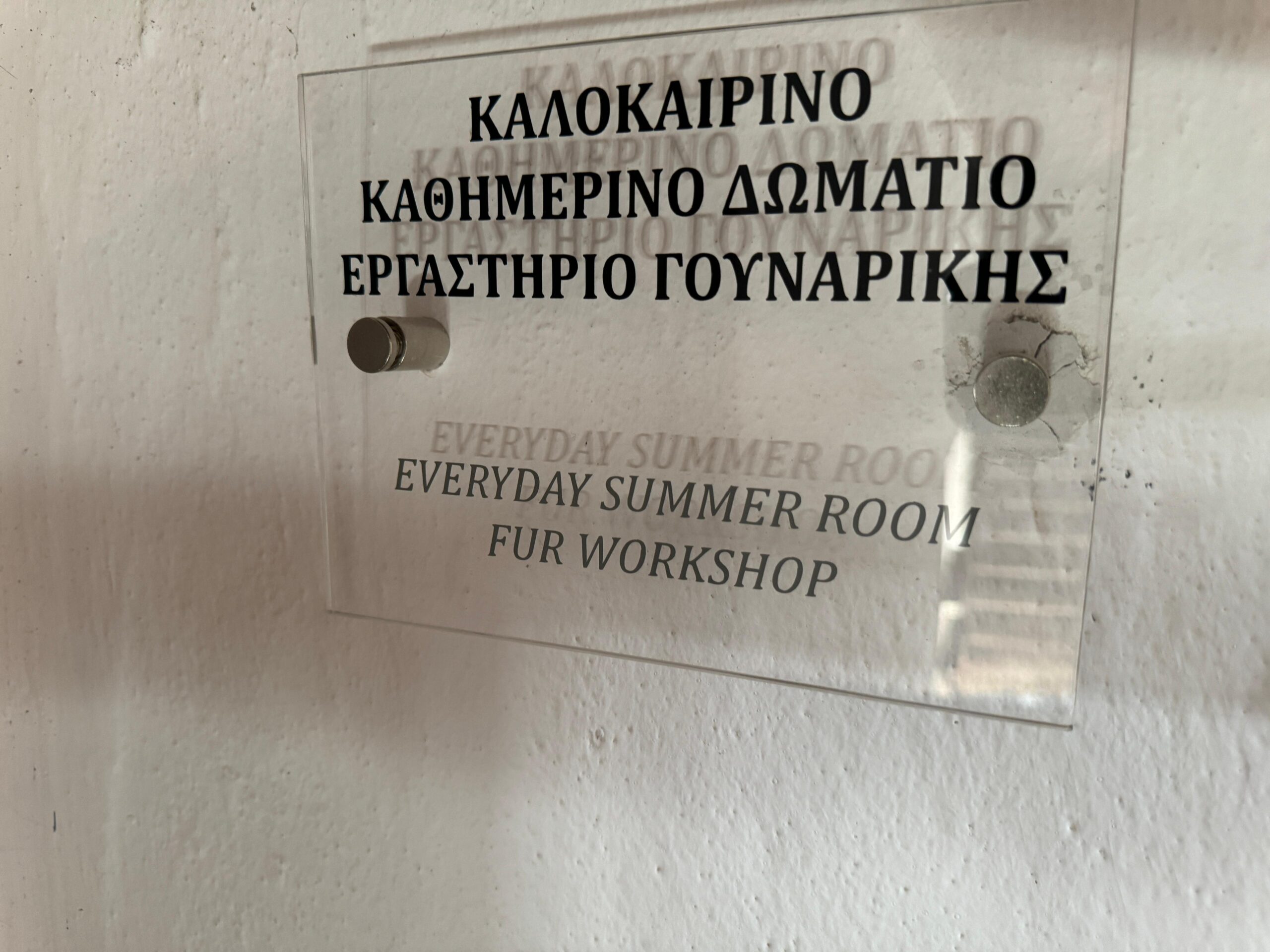


15. The Everyday Winter Room
Adjacent to the summer room is the Everyday Winter Room, a cozy haven during the colder months. The atmosphere here is warm and inviting, with rich colors and textures that envelop you like a comforting embrace.
“A grand ‘bouchari’ fireplace dominates one wall, its hearth large enough to gather around. Imagine the flames dancing, casting a golden glow that illuminates the faces of family members seated nearby.
The room is furnished with plush cushions and low tables. Walls are adorned with tapestries and embroidered fabrics, each one telling a story or depicting scenes from local folklore.
Evenings here were times of togetherness. Picture the family engaged in ‘night work’, the term for activities that occupied them after sunset. The women might be knitting or weaving, their needles clicking softly as they create garments and textiles.
The men might be carving wood or repairing tools, their conversations weaving tales of history, humor, and wisdom. Children listen with rapt attention, learning from the stories and absorbing the values shared.
The room is filled with the aroma of herbal teas and the occasional treat of roasted chestnuts or sweet pastries. Music often accompanies these gatherings, with someone playing a lute or softly singing a traditional song.
This space embodies the essence of home—a place where warmth is both physical and emotional, where bonds are strengthened, and traditions are cherished.


16. Parlor (Krevvata)
The transition into the Parlor is seamless, yet the ambiance shifts to one of refined intimacy. The room is adorned with luxurious fabrics, intricate rugs, and finely crafted furniture.
“Imagine guests being welcomed into this space, offered the finest hospitality. Soft chairs invite relaxation, and the walls are lined with shelves displaying delicate porcelain, silverware, and treasured family heirlooms.
The atmosphere here is one of quiet sophistication. Conversations are thoughtful, perhaps touching on art, literature, or the events of the day.
A grand mirror reflects the soft light, making the room feel even more spacious. Fresh flowers arranged in ornate vases bring nature indoors, their subtle fragrances enhancing the serenity of the space.
This room was reserved for important visitors, a place where first impressions were made and relationships strengthened.
Consider the care that went into maintaining this room—the meticulous dusting of intricate carvings, the careful arrangement of decor—all reflecting the family’s pride and attention to detail.


17. Balkony
Stepping onto the Balcony, you’re greeted by a panoramic view that takes your breath away. The garden stretches out below, and in the distance, the shimmering surface of the lake catches the light.
“Feel the gentle breeze as it carries the scents of blossoms and the distant sounds of the town. The balcony is adorned with potted plants, their leaves rustling softly.
This was a place of contemplation and connection to nature. Imagine Tasia standing here in the early morning, sipping a cup of herbal tea as the world awakens around her. Or perhaps Demetrios gazing out at the lake, reflecting on the successes of his trade and the well-being of his family.
The balcony offers privacy while embracing the openness of the outdoors—a perfect balance.
Linger here, absorbing the tranquility and the sense of timelessness. This is a place where the concerns of the world can be set aside, even if just for a moment.

18. Iconostasis
Re-entering the mansion, you approach the Iconostasis, a sacred space that emanates reverence and devotion.
“An alcove adorned with religious icons greets you, each image painted with exquisite detail and rich colors. The faces of saints and biblical scenes seem to watch over the household, offering protection and guidance.
A gentle glow from an ever-burning lamp casts a warm light, reflecting off the gilded surfaces. The scent of beeswax and incense lingers, creating an atmosphere of peace.
This was where the family gathered for daily prayers, moments of reflection, and to seek solace during challenging times. The crosses, candlesticks, and prayer books here are not just objects; they are conduits of faith and tradition.
The Iconostasis is a reminder of the central role that faith played in the family’s life, influencing their values, decisions, and connections to the community.
19. Cellar for Clothing
Descending a short staircase, you enter the Cellar for Clothing, a space that holds the family’s cherished garments and textiles.
“Rows of wooden wardrobes and chests line the room, each one housing items crafted with care. Open a drawer, and you might find finely woven linens, embroidered tablecloths, or delicate lacework.
Hanging from ornate hooks are traditional costumes, vibrant with colors and intricate patterns. These garments were worn during special occasions, each stitch reflecting hours of meticulous work.
Imagine Theodora carefully folding a newly completed shawl, its intricate design a testament to her skill. Or perhaps a young daughter trying on a festive dress, twirling with delight as the fabric swirls around her.
The cellar also stored materials for future projects—bolts of cloth, spools of thread, and baskets of wool ready to be spun.
This room speaks to the importance of textile arts in the household. It was a place of creativity and preparation, where the practical met the beautiful.



20. Room in the Eastern Wing
The Room in the Eastern Wing is a space bathed in soft light, with windows that capture the morning sun.
“This room may have served as a guest chamber or a quiet retreat for reading and study. The furnishings are comfortable but modest—a bed with a carved headboard, a writing desk by the window, and shelves filled with books and scrolls.
Imagine a scholar or a visiting relative staying here, finding solace in the tranquility of the space. The walls might have been adorned with maps or artwork, stimulating thought and conversation.
Perhaps this was also a place where children received lessons, the family valuing education and the pursuit of knowledge.
The room’s simplicity contrasts with the grandeur of the reception areas, highlighting the varied purposes within the mansion.
21. Good Winter Room
Returning to the northern side, you enter the Good Winter Room, a place of comfort during the coldest months.
“The fireplace here is grand, its mantle adorned with family portraits and cherished keepsakes. The room is arranged for conversation, with chairs and sofas positioned to encourage interaction.
Imagine evenings spent here with extended family and friends. The air is filled with the rich scent of burning wood, and the soft glow of the fire casts dancing shadows.
Stories are shared, from folklore to personal anecdotes. Perhaps a guest recounts tales from distant travels, captivating listeners with accounts of far-off places.
Refreshments are served—hot spiced wine, sweet pastries, and roasted nuts. The atmosphere is one of coziness and camaraderie.
This room embodies the essence of hospitality and the joy of shared experiences. It reflects the family’s desire to create a welcoming environment for all who enter.



22. Middle Room
Adjacent to the Good Winter Room is the Middle Room, a modest space that served practical purposes.
“This room may have been used as a weaving room or a workspace for various household tasks. A large loom could have dominated the area, threads of different colors stretching across its frame.
Imagine the rhythmic clacking of the loom as fabric is woven, the weaver lost in the meditative process. The walls might be lined with shelves holding spools of thread, baskets of wool, and patterns for new designs.
Alternatively, this room could have housed servants or been used for storage, reflecting the operational needs of the mansion.
While not as grand as other areas, the Middle Room was essential to the daily functioning of the household.
23. Gallery (Parthenon)
Climbing a discreet staircase, you reach the Gallery, or ‘Parthenon’, overlooking the Reception Hall.
“From this vantage point, women and girls could observe the festivities below without being seen. The gallery is enclosed with intricately carved screens, allowing a view while maintaining privacy.
Imagine the young women gathered here during a celebration, whispering and giggling as they watch the dancers and listen to the music. Their excitement is palpable, each one perhaps dreaming of future events where they will be the center of attention.
The gallery reflects the customs of the time, balancing societal expectations with the natural desire to participate in communal life.
It also served as a space for the women to share their own conversations and enjoy the festivities in their own way.


24. Formal Sitting Room
The Formal Sitting Room is a space of elegance and grace, reserved for special gatherings among women.
“Furnished with delicate chairs and tables, the room is decorated with fine art and beautiful textiles. Soft colors and floral motifs create an atmosphere of refinement.
Here, women would meet to share news, engage in needlework, or enjoy music and poetry readings. The room provided a sanctuary where they could express themselves freely and nurture friendships.
Imagine Theodora hosting a tea, the table set with porcelain cups and a spread of delectable treats. Conversations flow easily, touching on family, art, and the happenings within the community.
This room exemplifies the cultural importance of social interaction and the roles women played in maintaining the social fabric.



25. End of Tour
As we conclude our journey through the Nerantzis Aivazis Mansion, we hope you’ve felt the echoes of lives once lived here—the joys, the challenges, and the traditions that shaped them.
This mansion is more than a historical site; it’s a tapestry woven from the threads of countless stories. Each room, each artifact, holds memories that connect us to a time and place rich in culture and human experience.
Thank you for allowing us to share these stories with you. May the spirit of this home and the warmth of its history stay with you as you continue your own journey.
Before you depart, we invite you to explore any areas you wish to revisit, visit our museum shop for mementos, or speak with our staff if you have any questions.
Safe travels, and we look forward to welcoming you back to the heart of Kastoria.

